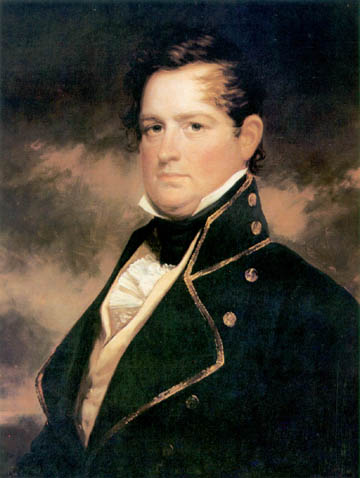
Peter Buell Porter
PETER BUELL PORTER was born at Salisbury, Connecticut, on 14 August 1773; graduated from Yale College in 1791; studied law at Judge Tapping Reeve’s school at Litchfield, Connecticut; moved to Canandaigua, New York, in 1795; entered into the practice of law; was clerk of Ontario County, 1797–1805; served in the New York legislature, 1801–1802; moved to Black Rock on the Niagara River; was a member of the firm of Porter, Barton & Company which controlled transportation on the Niagara Falls portage; served in the U.S. House of Representatives, 1809–1813; served on a commission on inland navigation established in 1810 to survey a Lake Erie–Hudson River canal route; was a leading figure among Congressional "war hawks" and chairman of the committee that recommended preparation for war with Great Britain; was quartermaster general of New York militia, May–October 1812; participated in and criticized General Alexander Smyth’s abortive operations against British Canada, 1812; fought a bloodless duel with Smyth; raised and commanded a brigade of New York militia that incorporated a Six Nations Indian contingent; led his command with distinction in the battles of Chippewa, Lundy’s Lane, and Fort Erie, 1814; again served in the Congress, 1814–1816; served on the U.S.-Canadian boundary commission, 1816–1822; was Secretary of State of New York, 1816–1817; was defeated by De Witt Clinton for the New York governorship; married Letitia Breckinridge, 1818; was a regent of the State University, 1824–1830; served as Secretary of War, 26 May 1828–9 March 1829; advocated removal of Eastern Indians beyond the Mississippi; retired to private life; died at Niagara Falls, New York, on 20 March 1844.
The Artist
Daniel Huntington (1816–1906), the New York portrait, historical, and landscape painter, faced the same problems that confronted several of his fellow artists who were commissioned in the 1870’s to execute portraits of early Secretaries of War. To produce likenesses that were reasonably contemporary to a subject’s stewardship, especially when the office-holder had served before the inception of the daguerreotype and photography and was no longer living to pass upon the finished work, the artist had no recourse except to consult a predecessor’s work. Huntington’s portrait of Porter falls into this category.
[42]
PETER BUELL PORTER
J. Q. Adams Administration
By Daniel Huntington after Matthew Harris Jouett
Oil on canvas, 29½" x 24½", 1873
page created 1 March 2001